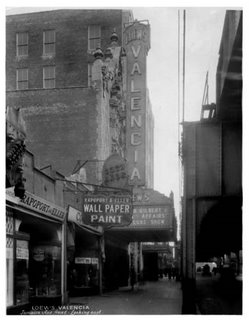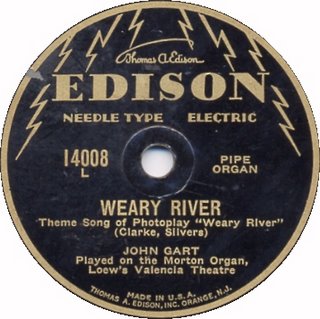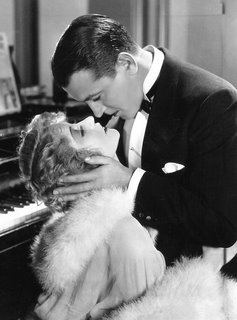But, for a brief time --- at the dawn of the sound film, the two elements not only co-existed, but did so peacefully... if not a bit uneasily. Established cinema orchestras would record elaborately arranged medleys and overtures for early musical films that would, in turn, soon make them obsolete, and cinema organs in virtually every theater in which one was installed, would entertain and lull arriving and departing audiences with tunes from recent and forthcoming films. Most established radio stations had one too, which was called into use whenever air time needed to be filled --- in addition to setting the appropriate mood and theme music for numerous early radio shows. So accepted and appreciated was the sound of this instrument, that it's rare to see an early radio broadcast schedule without noticing one or more "Organ Interludes" placed throughout the broadcast day.
Among the comparatively few recorded examples that survive today (radio transcription discs of the late 20's and early 30's have an especially low survival rate) a few have struck me as especially evocative and are well worth sharing here.
 On a cold day in late March of 1929, a day that I imagine looked not far different than the view seen here, performer John Gart was called upon to play the installed Morton Organ at the Loew's Valencia theater (Queens, New York and still extant, remarkably) for the purpose of recording a disc for the Edison Phonograph Company, an organization soon to cease operation forever for a variety of sad yet inevitable reasons.
On a cold day in late March of 1929, a day that I imagine looked not far different than the view seen here, performer John Gart was called upon to play the installed Morton Organ at the Loew's Valencia theater (Queens, New York and still extant, remarkably) for the purpose of recording a disc for the Edison Phonograph Company, an organization soon to cease operation forever for a variety of sad yet inevitable reasons.Edison's relatively new "Needle Type" electric records, while of superb quality, would come far too late in the game to make much of an impression, aesthetic or financial, and would prove to be the last dying gasp of a company that served to introduce recorded sound to much of the world's population.
It's a bittersweet experience to listen to this recording when you pause to consider the bleak outlook for both the recording company and the instrument being played --- and even more so, perhaps, when it's discovered that the selected tune is a "theme song" from an early hybrid form of sound film, the part-talkie. Bittersweet because it was the Edison company that attempted to develop and nurture the medium of the talking film long before it was technologically possible and was, in effect, a stillborn life. And yet, at the very end of the Edison company's life, here it was... witnessing and promoting the very medium it helped to create.

The tune, "Weary River," is from the Warner Bros. & First National photoplay of the same name, a part-talkie released early in 1929... and a film which somehow managed to beat the odds and survive intact today, looking and sounding much as it did when first released: sharp, clear and vibrant.
As with most part-talkies, and indeed early talkies in general, it's an easy target for derision by a modern audience clearly divided between a fondness for the silent film and the smooth, established talking film that would emerge by 1930. Therefore, it can't help to not entirely satisfy either faction in some way... and, as with most things, it's easier to find fault and laugh at something rather than attempt to understand it as best we can.
That aside, there's no denying that for the audiences who originally attended the film, it must have been a startling revelation to hear the long established star of the film, Richard Barthelmess, speak from the screen for the first time, as he did some ten minutes into the film's running time. The film, when seen from this difficult but rewarding viewpoint, is a fascinating artifact of both cinema and technology history --- not to mention moderately painless entertainment.
Audio addendum:

1) Theme song of the Photoplay "Weary River," as performed by John Gart on the Loew's Valencia Theatre Morton Wonder Organ in March of 1930. (Pictured right, Richard Barthelmess and Betty Compson in a scene from the film.
"Weary River" (1929)
2) "My Song of the Nile," the theme song of the 1929 Warner Bros. film "Drag," a lost silent film (also starring Richard Barthelmess) that was released with a synchronized Vitaphone music and vocal effects soundtrack. Performed here in October of 1929 by Newell Alton on the Capitol Theatre, Melbourne, Australia. A fine vocal refrain is also featured, although whether or not it's provided by the organist is unknown. One needs an exceptionally robust voice to sing with a pipe organ, and the fellow here, whoever he may be, is more than up to the task!
"My Song of the Nile" (1929)
3) "Am I Blue?", from the 1929 Warner Bros. All-Technicolor film "On With the Show!," as performed by Jean DePayne on the 23rd of August, 1929 and released on the Romeo 78rpm label. Again, it's unknown if the plaintive vocal is by the organist. Should anyone be able to verify the vocalist on this and the previous recording, you're invited to contact me.
"Am I Blue?" (1929)
###
Great comments Jeff. Ive seen Weary River and found it perfectly entertaining. The only disappointment was learning that Richard Barthelmess wasn't actually doing his own singing. Still, Richard turned in his usual fine performance.
ReplyDelete